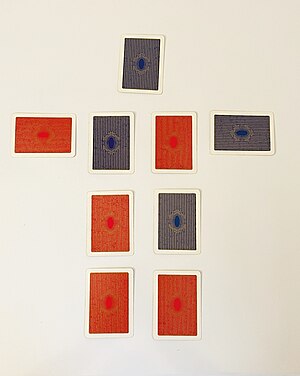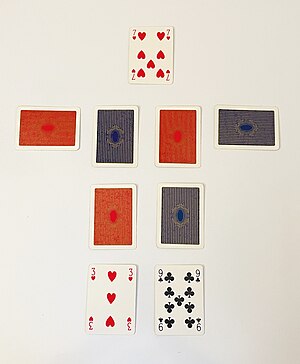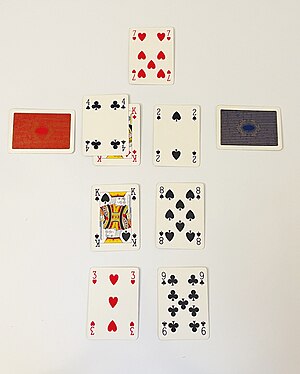Summicard
Script error: No such module "AfC submission catcheck".
Summicard is a card game born in Italy that is played with at least one pack of french-suited playing cards of which only the numerical value is considered and not the suit. It can be played by two to an infinite number of players by adding new decks. It is a fast game (games can last even just a few minutes) and suitable for all ages.
Origin and etymology[edit]
The game was conceived in 2022 by Daniele Giudici and Ginevra Roberta Cardinaletti and presented in the Italian magazine TUTTO mese,[1] and on the Quootip.it[2] website. The name Summicard derives from the game mechanism which is based on the use of addition and subtraction to reach the final victory. The creators were inspired by the game of bowls where the goal of the players is given by the proximity of their bowls to the Boccino (the smaller ball).
The rules of the game[edit]

Cards[edit]
In Summicard the cards take on a name based on their position on the table:
- Boccino Card: It is a card placed in the center of the table. Applies to all players.
- Main Cards: These are three cards exclusive to each player.
- Bomb Card: It is an additional card that each player has.
The value of the cards ranges from 1 (ace) to 13 (the K) and only their numerical value is valid therefore: 1 (Ace), 2, 3, 4, 5, 6, 7, 8, 9, 10, 11 ( J), 12 (Q), 13 (K). It is played without the jokers and without considering the suit (Hearts, Spades, Clubs and Diamonds) which have no value here. It can also be played with Italian cards but in this case the cards are worth from 1 (ace) to 10 (the king).
Preparation[edit]
One player is the Dealer then manages the deck and deals cards to the various players: four cards each (3 Main cards and 1 Bomb card). The Main cards are placed in a vertical row in front of the player, while the Bomb card is next to the last main card in a horizontal position. Finally, the Dealer places the Boccino card in the center of the table, clearly visible to all players. The Dealer turns over the Boccino card and makes sure that everyone sees it.

The game[edit]
The player to the Dealer's right starts who reveals its first Main card, the one closest to it, and determines the score which is given by the difference between its Main card and the Boccino. The score must be positive and never negative. Example: if the card is a 9 and the Boccino is a 7, its score is 2. The score is 2 even if its card is a 5. Afterwards, each player does the same, concluding the first round.
This process is also identical for the second and third hand with one difference, in these two cases the player can choose to change one of its main cards after having revealed it. Each player can only change once and only on the second or third hand, never during the first and/or fourth hand (the discovery of its Bomb card). It can only change the newly revealed main card, so it cannot change its second Main card after revealing its third Main card.
After revealing all of its Main cards, the player must add up its scores. Example: in the first hand the score was 2, in the second hand it was 1 and in the third it was 5, so its final score is 8. All players must do the same so that everyone has a score personal.

In the fourth hand, each player reveals its own Bomb card which will have a value obtained with the same mechanism (the difference with the value of the Boccino). Also in this case the value must be positive and never negative. Example, if the Bomb card is worth 4 and the Boccino card is worth 7, the Bomb score is 3.
The player must subtract this value from the one obtained from the sum of its Main cards. Example: if the sum is 8 (2+1+5) and the Bomb is worth 3, then its final score is 5. In this case the score can also be negative: for example, if the final sum is 8 and the Bomb's value is 9, its score is –1.
Winner and end of game[edit]
The player with the lowest positive final score (greater than 0) wins, regardless of the value of the Boccino. Anyway, some situations can happen like:
- Multiple winners (players with the same final score): After the game, these players get from the Dealer one more card from the deck and subtract its value from the Boccino value. Whoever has the lowest score wins. In case of a further tie, it goes to the bitter end.
- Negative score: By subtracting the value of the Bomb card, the player ends up with a negative value (less than 0) and in this case it "busts" and is eliminated.

Variant[edit]
Summicard can also be played with bets that determine a final jackpot. In this case, the steps are:
- Before the game: Each player pays one chip entry.
- Before the second and third hand: The player checks its card and decides to:
- Pass: Does nothing and stays with the initial cards, allowing the next player to continue the game.
- Buy Exchange: Pay a chip to exchange its Main card (important: it can only be exchanged once per player).
- Before the fourth hand (the discovery of the Bomb card): Each player secretly looks at its own Bomb card without being seen by the others. At that point, knowing its value but without discovering it, it has to make a cheap bet at its convenience. The next player can:
- See: Pay the same amount decided by the first player and go on in the game.
- Raise: Pay the amount decided by the first player and add a further amount.
- Abandon: Does not pay any amount and exits the game.
If a subsequent player raises, then the round begins again until all players have bet the same amount. In the event that a player raises and no one calls its raise but everyone folds, then the raiser will be the winner of the game and win the jackpot. In the end, the player with the lowest score wins the pot.
External links[edit]
- The rules of the game, on Quootip.it.
- The variant, on Quootip.it.
Note[edit]
Related items[edit]
This article "Summicard" is from Wikipedia. The list of its authors can be seen in its historical and/or the page Edithistory:Summicard. Articles copied from Draft Namespace on Wikipedia could be seen on the Draft Namespace of Wikipedia and not main one.
